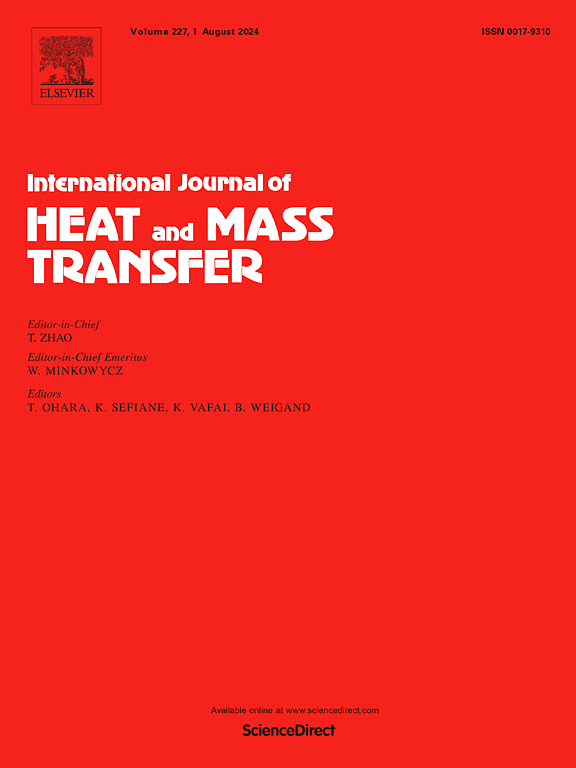带有吹扫-主流密度比的入口波模型
IF 5
2区 工程技术
Q1 ENGINEERING, MECHANICAL
International Journal of Heat and Mass Transfer
Pub Date : 2024-11-16
DOI:10.1016/j.ijheatmasstransfer.2024.126372
引用次数: 0
摘要
航空发动机的冷却流(吹扫流)的吹扫流-主流密度比(DR)很大,这主要是由这两股气流的温度差造成的。本文将介绍 DR 对进气、吹扫流量和密封效果的深远影响,所有这些对于实现发动机的高热力学效率这一首要目标都至关重要。本文介绍了一种新的理论(低阶)模型,使发动机设计人员能够灵活地预测所需的吹扫量,以防止在一系列典型工作条件下的进气。进气道波模型基于以下物理原理:以大范围旋转不稳定性为形式的不稳定性会形成一个圆周压力梯度,驱动流体对抗科里奥利力而运动。相邻流体切向动量差产生的剪切力被假定为这一过程的主要机制。这样就可以从尺寸分析中推导出一套方程,并假设流体夹带是相对出口动量和入口密度的函数。该模型根据 DR = 1 和 1.52 条件下收集的数据进行了验证,在一定范围内的吹扫和环形流动条件下,模型的定量一致性良好。典型的发动机设计实践利用了在低技术就绪水平(TRL)和 DR = 1 的良性条件下运行的实验钻机中获取的信息。新模型用于将从六个实验设施中收集到的此类数据放大到当前最先进(DR = 1.5)和未来(DR = 2)发动机的预期密度比。其结果是要求大幅降低吹扫量,这对发动机设计者具有深远的实际影响,尤其是对未来以更高吹扫量-主流密度比运行的发动机。本文章由计算机程序翻译,如有差异,请以英文原文为准。
Ingress wave model with purge-mainstream density ratio
Aeroengines operate with a cooling flow (purge) at a significant purge-mainstream density ratio (DR), which is principally created by the differences in temperatures of these two streams. This paper will show there is a profound influence of DR on ingress, purge flow rates, and sealing effectiveness - all crucial to the superordinate aim of achieving a high thermodynamic efficiency for the engine. A new theoretical (low-order) model is introduced to enable the engine designer to flexibly predict the required purge to prevent ingress over a range of typical operating conditions. The Ingress Wave Model is based on the physical principle that unsteadiness, in the form of large-scale rotating instabilities, forms a circumferential pressure gradient driving fluidic motion against the Coriolis force. The shear created by the difference in tangential momentum between adjacent flow streams is assumed to be the primary mechanism in the process. This allows a set of equations to be derived from dimensional analysis and the assumption that flow entrainment is a function of the relative egress momentum and ingress density. The model is validated against data collected at both DR = 1 and 1.52, with good quantitative agreement across a range of purge and annulus flow conditions. Typical engine design practice exploits information captured in experimental rigs operating in benign conditions at low technology readiness level (TRL) and DR = 1. The new model is used to scale such data collected from six experimental facilities to the density ratios expected in current state-of-the-art (DR = 1.5) and future (DR = 2) engines. The result is a requirement for significantly reduced purge, with profound practical implications for the engine designer, in particular for future engines which operate at higher purge-mainstream density ratios.
求助全文
通过发布文献求助,成功后即可免费获取论文全文。
去求助
来源期刊
CiteScore
10.30
自引率
13.50%
发文量
1319
审稿时长
41 days
期刊介绍:
International Journal of Heat and Mass Transfer is the vehicle for the exchange of basic ideas in heat and mass transfer between research workers and engineers throughout the world. It focuses on both analytical and experimental research, with an emphasis on contributions which increase the basic understanding of transfer processes and their application to engineering problems.
Topics include:
-New methods of measuring and/or correlating transport-property data
-Energy engineering
-Environmental applications of heat and/or mass transfer

 求助内容:
求助内容: 应助结果提醒方式:
应助结果提醒方式:


